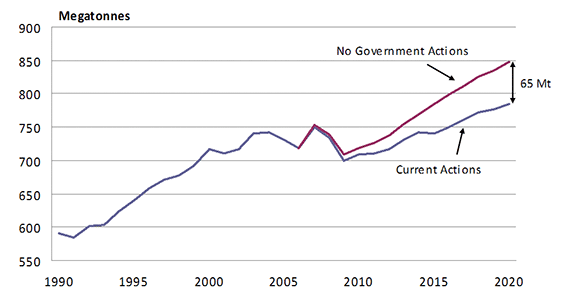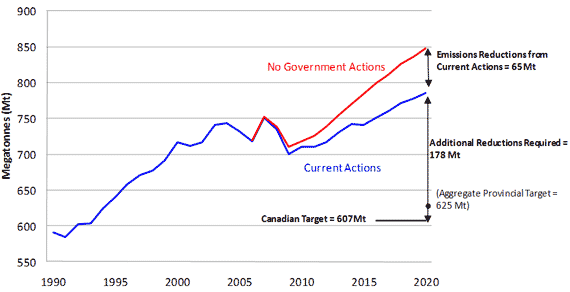
Environment Canada
July 2011
Previous page | Table of Contents | Next page
Canada’s target of reducing greenhouse gas emissions 17 per cent below 2005 levels by 2020 requires that emissions decline to 607 Mt by 2020.
So far, federal and provincial governments have taken significant measures to reduce emissions. Existing federal initiatives include fuel efficiency regulations for light-duty vehicles, renewable fuels standards, and the Emissions Performance Standard for coal-fired electricity. Provinces and territories have also taken action within their respective jurisdictions, through a wide range of measures. Some notable examples include: British Columbia’s carbon tax, Alberta’s industrial regulations, Nova Scotia’s regulation of electricity GHG emissions, Ontario’s phase-out of coal-fired electricity and Quebec’s carbon levy. Additional details on these existing federal and provincial measures are provided in Annex 1.
The baseline scenario for GHG emissions takes into account the impact of these existing measures on emissions.
Figure 5 indicates that these existing measures would limit GHG emissions in 2020 to about 785 Mt. It shows that significant progress in reducing 2020 emissions has been achieved by existing measures. Without government measures, emissions in 2020 would be 65 Mt higher, and would reach 850 Mt. Each level of government has contributed in roughly equal measure to the overall reduction in emissions to date.
Figure 5 Baseline Emissions Scenario with and without Government Actions

Figure 6 shows that the reduced emissions including current measures are still higher than Canada’s target of 607 Mt, and further federal and provincial measures are required in order to generate the additional 178 Mt in emission reductions needed to achieve that objective.
The 65 Mt in reductions by 2020 from existing federal and provincial measures represent about one quarter of the reductions needed to achieve the target of 607 Mt by 2020. At the same time, each province in Canada has adopted emissions reduction targets for their respective jurisdictions (a list of targets is available in Annex 1). Adding up provincial government targets for GHG emissions across the country results in an aggregate provincial target for GHG emissions of 625 Mt in 2020. This aggregate provincial target is only slightly higher than the Canadian target of 607 Mt.
More work is required to achieve the reductions required to meet the Canadian target, and more work is also required to meet the aggregate provincial target. At the federal level work is underway that will lead to additional reductions. As the government advances additional measures under its climate change plan, future emission reductions will continue to accumulate, thereby pushing projected emissions in 2020 down to the levels required to meet the 2020 target. For example this scenario includes the impact of light-duty vehicle regulations for model years 2011 to 2016, but the impact of the second phase of light-duty vehicle regulations starting in 2017, and heavy-duty vehicle regulations starting in 2014, have not yet been included. Once the details of these measures have been announced and they are taken into account in the baseline scenario, projected emissions in 2020 will decline further below the projected levels shown here. Similarly, once additional measures in other sectors and additional provincial actions are announced and taken into account, projected emissions in 2020 will decline further.
Figure 6 Scenarios of Canadian Emissions to 2020 (Mt CO2e)
